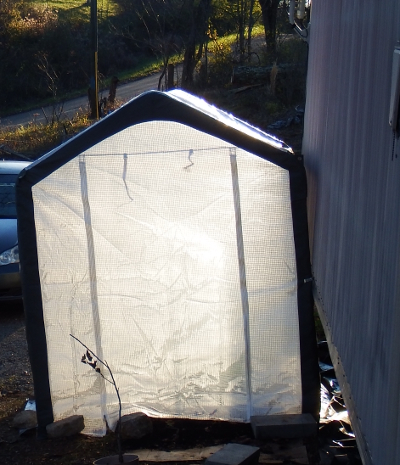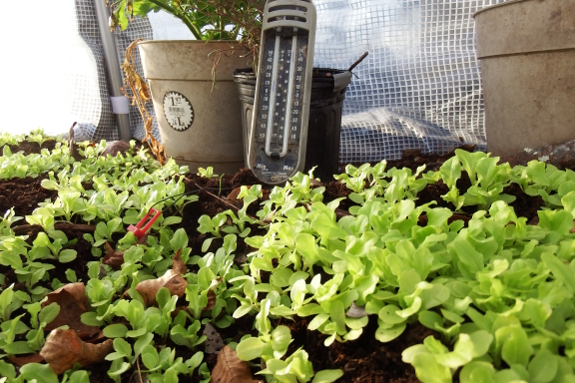
Mini-greenhouse info
 We had several thoughtful
comments about our new
mini-greenhouse.
Let's see if I can answer them all in one post!
We had several thoughtful
comments about our new
mini-greenhouse.
Let's see if I can answer them all in one post!
"I'd
love to know the brand name & what you think of the quality. From
the pic, I'm impressed by what looks like reinforced corners. Or are
they just a different color?" --- Terry
This is a 6 foot by 8
foot Garden Treasures greenhouse that Lowes used to sell for a couple
of hundred bucks. I believe Rose Nell found it on sale for $69, likely
because the model has been discontinued. The plastic is pretty thick
and the corners are reinforced, which is both a pro and a con --- the
material will likely last longer but will also block some light.
Although you can't find
the Garden Treasures greenhouse in the stores any longer, it looks
quite similar to this model on Amazon.
"Got
any idea as to how long that plastic will last before it breaks down in
the sun?" --- Nayan
This is the flaw in any
type of discontinued product like this --- replacement parts are
unavailable. My plan is to try to rig a new covering out of rolled
greenhouse plastic once the original dies. I hope we don't have to
figure out whether that works for several years!

"How
much of a temperature boost will a greenhouse like this give winter
crops?" --- me
So far, on a clear night
after a sunny day, the greenhouse seems to be providing a couple of
degrees sheltering effect. I suspect the longer-term impact will be due
to raising soil temperature during the day and giving winter growers
more oomph, but we'll have to wait and see how that pans out.
I took a photo of the
lettuce in the greenhouse and another bed of lettuce (slightly bigger)
under a simple layer of row-cover fabric and will report back in a
couple of weeks once the two data points have time to diverge. Stay
tuned!
Want more in-depth information? Browse through our books.
Or explore more posts by date or by subject.
About us: Anna Hess and Mark Hamilton spent over a decade living self-sufficiently in the mountains of Virginia before moving north to start over from scratch in the foothills of Ohio. They've experimented with permaculture, no-till gardening, trailersteading, home-based microbusinesses and much more, writing about their adventures in both blogs and books.
Want to be notified when new comments are posted on this page? Click on the RSS button after you add a comment to subscribe to the comment feed, or simply check the box beside "email replies to me" while writing your comment.

Clear polycarbonate sheet (the most well-known trade name is probable "Lexan") would be a superior choice for the walls of a greenhouse. It is very translucent and impact resistant. Something in the order of 1/8 to 1/10 inch thick solid sheet should do very well when assembled on an e.g. wooden frame. Instead of solid sheet, you can also get double-wall extrusions. In that case you trade some translucency for better insulation. It is quite expensive, but it should last for many years.
A cheaper alternative could be acrylic (trade names "Plexiglass", "Prespex") sheet. It is also very translucent but doesn't have the impact resistance of polycarbonate.
Roland, I've been using acrylic plastic sheets from Lowes on my coldframe. I believe I build the coldframe in 2003 and it has held up very well. There are a couple of problems I find with it (and it may just be me and not a universal problem): 1) I have trouble cutting to size without cracking the sheet which is why I usually ask Lowes to cut the sheet to whatever size I need; and 2) over a period of years, the clearness of the plastic fades and it becomes cloudy, which doesn't really seem to hurt the amount of sunlight that the cold frame gets. The only other problem is stupidity on my part when I inadvertently forgot to put a weight on one of the lids (the frame's designed to be accessed from both sides) on one side and the wind (I live in a wind tunnel, or so it seems) blew the cover back, cracked the plastic and mangled the frame of the lid. The other side has one of those automatic heat venting mechanisms (which work great!) so the wind can't lift the lid and try to blow it into the next county.
Although I think using acrylic for a coldframe is a great idea, I think it would be cost-prohibitive for a greenhouse and going with either flexible greenhouse plastic or the double-walled kind would probably be a better choice. You can get it from Charliesgreenhouse.com. I've purchased some items from them and have been satisfied with their products.
We just got our greenhouse this past week. It's a bit smaller than yours. This is our first one so it's a new experience for us. I would greatly appreciate any tips on getting started so I will definitely be looking for your updates on your greenhouse growing. What's good to start out with in the middle of December?
JenW~
Roland and Nayan --- I appreciate your input on covers for the future! Always good to have that filed away attached to a blog post to speed up later research.
Jen --- Congratulations on your new greenhouse! That's a tough question, though --- there's not much you can start so late in the year. You might try lettuce if you only expect a jump start on production in the spring --- maybe a February first harvest instead of March. Or possibly kale with the same plan? Please do tell me what you decide to do and how it works out!
I have become a fan of this guy's YouTube videos on growing in a greenhouse. He's in zone 5, and obviously got a lot of his info from Elliot Coleman (who's videos back in the 90s I would religously tape. Unfortunately, the VHS machine is now kaput.) Anyhow, he has some really good tutorials on growing veggies, when to, how to, and how to make a hoop greenhouse and cold frames within the greenhouse. His videos can be found here: https://www.youtube.com/user/OneYardRevolution
As the old commercial goes: Try it! You'll like it!
Menards has a twin wall extruded polycarbonate in stock by me in Michigan 4'x8'x6mm thick for less than $40.
Tuftex® 4' x 8' Polycarbonate Clear Twinwall Panel (6 mm)
They are quite durable, and offer some insulation in the double-wall.
I've worked both acrylic and polycarbonate sheet, and they are BOTH a PITA. Use them only if NOTHING else will do.
I have two fabric structures that were initially covered with translucent rip-stop sheeting like your greenhouse. The one shaded by the house is still intact 14 years later. In direct sun, the roof of my larger structure ripped after about 5 years, and was replaced by opaque vinyl (it's a shop)
More on the rip-stop greenhouse film: http://www.shelter-systems.com/dome-coverings.html
@Nayan:
How are you cutting the acrylic? Thin sheets (say up to 4 mm) can be scored with a knife and then broken. Personally I don't like this method very much because you can get razor-sharp edges this way. But using a jigsaw or circular saw gives a better quality edge. When using any powered saw, use a sawblade with fine teeth. Do make sure the acrylic is well supported so it doesn't chatter. Personally I tend to cut plastic sheets on the table saw at work using a ⌀300 mm, 96-teeth carbide-tipped saw. That works very well. The only downside is that the chips coming off tend to clump together and clog up the extraction pipe.
Clouding of acrylic is surprising. Acrylic is known for its good resistance to UV. But exposure to certain substances can cause discoloration or crazing. Note that you should not clean acrylic with solvents! That includes methylated spirits and pure isopropyl alcohol. If the hazing is on the surface (which one would expect if its caused by a substance instead of UV) you might be able to polish it out.
BTW, I would not recommend using countersunk screws in acrylic. It's very easy to crack the material that way. Put a washer under screw-heads to spread out the load from the screw over a larger area, and don't over-tighten the screw.